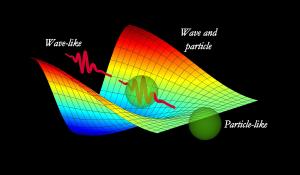Blog
Duality
7 March 2014
 S. Tanzilli, CNRS
S. Tanzilli, CNRSWhen quantum theory is presented in popular science, it is often presented as a strange or spooky thing where particles can act like waves and waves can act like particles. It usually focuses on experiments such as the double-slit experiment where the photon or electron “knows” how the experiment is done and alters its behavior accordingly. This is rather unfortunate, because although quantum theory can seem strange, it is hardly mysterious. It basically comes down to a concept known as duality.
One way to think of duality is to imagine a book with a tack taped to the front cover point side up. In this way, the point of the tack will always point out from the cover of the book. If you then hold the book up, that’s still true. So if you know the direction the tack is pointing, you also know the orientation of the book. Likewise, if you know the orientation of the book, you know what direction the tack is pointing.
Suppose then, that someone asked you whether the direction of the tack determines the orientation of the book, or the orientation of the book determines the direction of the tack. You might explain that it isn’t one determining the other. The book and tack are always related in the same way, so knowing one you know the other. In other words there is a duality between the tack and the book.
In quantum theory there is a similar duality between particles and waves. This means it isn’t about whether particles act like waves or waves act like particles, but rather that quantum objects have a connectedness between their particle and wave aspects. One consequence of this is that quantum objects are neither particles nor waves in the traditional every-day sense. They are particles with wave properties and waves with particle properties. This means light waves can be described as a collection of photons, and particle-like electrons have a wavelength.
In the mathematical formalism of quantum field theory you don’t need to distinguish between particles and waves. Often extended (non-local) phenomena are described as being waves, and local phenomena as particles, but you can also simply stick to the mathematical formalism. Objects are quantum fields, and can be treated as such.
But given that waves and particles are easier to visualize than quantum fields, we do tend to refer to objects as particles or waves depending on what aspects of an object we are focusing on. This is particularly true when describing things at a popular level. This is why we’ll talk about protons colliding and fusing in the core of the Sun as if they are particles, while at the same time talking about the light emitted by a supernova as an electromagnetic wave. In reality, both are quantum fields.
Quantum theory can be a bit strange, but there isn’t anything mysterious or magical about it. Objects do not choose to be a particle or wave depending on how we observe them. The measurements we make simply affect the objects, and the type of measurements we make determine the properties of an object we can observe. That fact won’t stop us from referring to objects as either particles or waves most of the time. It’s just easier to explain that way.
But underneath that simple particle/wave view of things is the duality that is a fundamental aspect of nature.